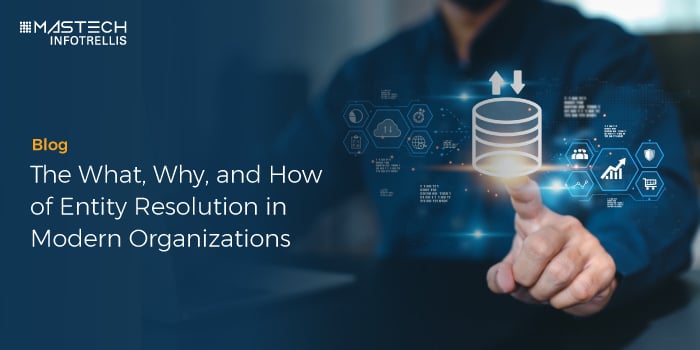Table of Content
TABLE OF CONTENTS

Introduction
As a powerful tool for modern organizations, entity resolution harnesses the unlimited potential of data and acts as a critical process for any business. In the world of data, it's not uncommon to come across multiple records for a single entity. Whether it's a customer, product, or location, data sets can contain a tangled web of information that needs to be sorted out. Entity resolution lays out a process for identifying and linking records that refer to the same real-world entity. This allows enterprises to unlock valuable insights and make informed decisions.
Entity resolution is a crucial process that plays a vital role in data management and analytics. Over the years, the importance of entity resolution in data management has steadily increased across industries. More organizations now recognize the value of entity resolution in improving data quality, accuracy, and consistency.
Unlocking Business Objectives with the Power of Effective Entity Resolution
Organizations implementing robust entity resolution solutions achieve their business objectives by enhancing their data quality and accuracy, identifying, and mitigating fraud and risk, improving customer experiences, and acquiring valuable insights from their data. Effective entity resolution enables organizations to make informed decisions and achieve outcomes through strategic planning based on reliable data.
Here are some key business objectives that organizations can accomplish with the support of entity resolution:
- Enhance Customer Experience – By consolidating and linking customer records, entity resolution enables organizations to achieve a comprehensive and accurate view of their customers. This is crucial to deliver personalized and relevant customer experiences, which can help increase loyalty and drive revenue.
- Improve Operational Efficiency – By automating the entity resolution process, organizations can reduce the time and effort required to reconcile data across multiple sources. It helps streamline data processing, improve data accuracy and reliability, and minimize error-prone manual data handling – leading to faster and more efficient business operations.
- Improve Data Quality – Entity resolution ensures identifying and linking of duplicate records, thus enhancing the accuracy and completeness of an organization's data, leading to better decision-making and more reliable insights. Resolved data reduces data inconsistencies and errors, leading to enhance customer experiences.
- Increase Regulatory Compliance – Effective entity resolution can help organizations achieve better regulatory compliance by ensuring data is accurate and up to date across multiple systems and platforms. It reduces the risk of compliance violations and penalties and helps achieve data privacy and security requirements.
- Better Risk Management – By enabling a unified, reliable, and comprehensive view of the entity and its relationships across the business, the entity resolution process aids in the proactive identification of high-risk profiles and suspicious relationship chains. It thus enables organizations to take preventive measures to mitigate risks, financial losses and protect their reputation.
Implementing an enterprise-wide entity resolution process is a challenging task that demands meticulous planning, coordination, and execution. It involves integrating and linking data across multiple systems and platforms to achieve ideal and holistic entity records. Therefore, proper planning and execution are essential to ensure the process succeeds and unlocks its true potential.
Before initiating entity resolution in organizations, it's essential to take stock of existing issues and then evaluate the next steps. Let's explore some best practices and critical considerations for organizations implementing entity resolution solutions.
- Defining Scope and Objectives –The scope of entity resolution should be clearly defined. This involves identifying the data sources to be included in the process, the type of entities to be resolved, and the level of accuracy required. This ensures the process is focused and aligned with the business goals.
- Assessing Data Quality – Before starting an enterprise-wide entity resolution process, it's important to assess the quality of your organization's data. This involves evaluating data completeness, inconsistencies, duplications, and more. This assessment will help design the required customizations needed for effective resolution.
- Identifying Stakeholders – Organizations should identify all stakeholders involved and impacted by the process. It is crucial to understand their needs and expectations for the resolution process.
- Developing a Cross-functional Team/SMEs – An effective entity resolution often requires organizations to build a cross-functional team to collaborate. Business users, data analysts, and other IT members will help build a comprehensive resolution process.
- Selecting the Right Technology Stack – Organizations can find the right technology stack for their specific needs with proper evaluation. This includes assessing data processing capabilities, scalability, and integration with existing systems.
- Developing a Governance Framework – A robust governance framework establishes clear policies, processes, and roles for managing and resolving entities. Entity resolution is a continuous process, and a clearly defined governance framework is crucial for monitoring and optimizing
Overall, entity resolution is an ongoing process that requires continuous attention to ensure the accuracy and integrity of your data. These considerations help design an organization-wide entity resolution pipeline efficiently and effectively.
Entity Resolution Pipeline
The ER process involves resolving entities and detecting relationships among them, typically through automated pipelines that handle incoming entity records. This process usually involves five phases:
-
Data Preparation/Cleansing – This phase involves preparing the data for analytics by cleaning and transforming it. It includes steps like data profiling to identify errors and inconsistencies, data standardization to ensure a standard format for comparison, and data cleansing to remove duplicate or irrelevant information.
-
Blocking – Blocking phase divides data into smaller, manageable subsets, or "blocks," based on specific attributes. This reduces the number of comparisons needed, thus improving processing time and efficiency.
-
Matching – Matching is an essential phase of the entity resolution pipeline which involves comparisons, defining match criteria, scoring, and rankings. Attributes of different records are compared to determine their similarity based on predefined match criteria. Various matching algorithms and techniques are applied to assess the degree of similarity between records. Standard techniques include exact/deterministic matching and fuzzy matching/probabilistic matching. The similarity scores obtained from comparisons are ranked to prioritize the most probable matches.
-
Clustering – It's the process of amalgamating similar records into clusters based on attributes and relationships. It helps identify data discrepancies and potential matches in large datasets. Clustering reduces computational costs and improves matching accuracy. It also uncovers new relationships and patterns in the data, providing valuable insights.
-
Entity Consolidation – The identified related records are merged into a single representation, combining each record's relevant attributes and information. Duplicate or redundant features are removed, and missing or inconsistent data may be resolved or imputed based on predefined rules or data augmentation techniques. Business rules and domain-specific criteria are applied to determine the entity representation.
Additionally, here are some essential factors to consider when developing an efficient solution for entity resolution:
- Scale – To effectively handle large amounts of data, it is crucial to incorporate automation, machine learning, and human expertise. This combination enables organizations to process vast data efficiently while maintaining accuracy and completeness in entity resolution.
- Performance – Performance optimization plays a vital role in ensuring the efficiency and accuracy of the entity resolution process. By leveraging advanced technologies, streamlining workflows, and implementing continuous improvement strategies, organizations can enhance the speed, productivity, and effectiveness of human stewards involved in resolving entities.
- Real-time and Batch Processing – The process should support batch and real-time entity resolution needs. The solution should support both real-time and batch processing for entity resolution needs. Batch processing should efficiently handle large data volumes, minimizing errors and improving accuracy. Additionally, the solution should be designed to detect and resolve entity matches in real-time, leveraging data streams, automated workflows, and expert human analysis to respond quickly and accurately.
- Deployment Overview – it is crucial to determine if it should be installed on-site or as a cloud-based solution, as its seamless ability to integrate with data sources and interfaces is required for smooth integration. The solution should be able to support upstream and downstream applications. This includes proper assessment and planning for required infrastructure, integration needs, speed/latency, availability, and reliability requirements to ensure it can handle the anticipated data volume and processing needs.
Entity resolution is a critical requirement across various industries and verticals. Whether in banking and finance, healthcare, retail, or any other domain, the need to accurately identify and resolve entities is pervasive. For instance, financial institutions face significant challenges in meeting KYC compliance, which amplifies their operational costs, becoming a cause of concern. However, effective entity resolution technology can add value and increase efficiency in –
- Customer due diligence
- Onboarding and account activation
- Surveillance
- Off-boarding
A real-time entity resolution solution allows for perpetual KYC updates, reducing costly remediation projects. Moreover, entity resolution technology improves the ability to detect financial crimes such as money laundering, human trafficking, and terrorist financing while reducing the number of false positives. It facilitates the prompt identification of suspicious activity, empowering investigators to file relevant reports and take necessary action swiftly. Further, entity resolution contributes to stronger regulatory compliance while driving operational efficiency and customer trust.
Conclusion
In today's data-driven world, entity resolution is integral for organizations seeking to improve their decision-making capabilities and acquire a competitive advantage. Organizations can improve data quality, reduce redundancy, and gain valuable insights into their data ecosystem by effectively resolving entities. The key to successful entity resolution is a combination of advanced algorithms, expert human analysis, and well-defined governance policies.
Effective entity resolution can unlock the full potential of your data for better decision-making, sustainable growth, and success. Mastech InfoTrellis is well-placed to deliver efficient entity resolution solutions to organizations looking to improve their data management practices. Our experienced data experts have a deep understanding of modernizing data systems, the challenges involved in implementing effective entity resolution solutions, and the expertise to develop and deploy solutions that meet the unique needs of their clients. In 2022, we saw an attrition rate of just 9% against an industry average of over 25%, demonstrating the company's commitment to excellence and innovation, making us a trusted partner for organizations seeking to improve their data management capabilities. Partnering with us, organizations can benefit from industry-leading expertise and cutting-edge technology, ensuring they are well-equipped to manage their data effectively and achieve their business goals.

Deepti Soni
Director, Data Science and Analytics
Deepti Soni is a Data Science professional with more than ten years of experience in architecting innovative analytical solutions for strategic business problems.
-2.jpg?width=240&height=83&name=Menu-Banner%20(5)-2.jpg)
.jpg?width=240&height=83&name=Menu-Banner%20(8).jpg)

